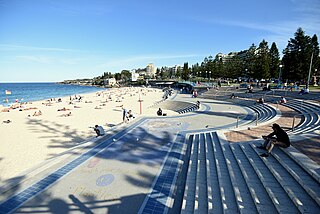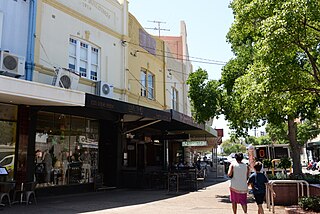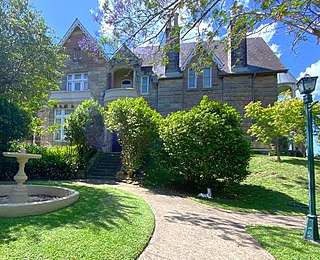
Randwick is a suburb in the Eastern Suburbs of Sydney, in the state of New South Wales, Australia. Randwick is located 6 kilometres south-east of the Sydney central business district and is the administrative centre for the local government area of the City of Randwick. The postcode is 2031.

Coogee is a beachside suburb in the Eastern Suburbs of Sydney, New South Wales, Australia, eight kilometres south-east of the Sydney central business district.

South Coogee is a coastal suburb in the Eastern Suburbs of Sydney, in the state of New South Wales, Australia. South Coogee is located 9 kilometres south-east of the Sydney central business district, in the local government area of the City of Randwick.

The Spot is a locality in the Eastern Suburbs of Sydney, New South Wales, Australia, south-east of the CBD. The Spot is located in the south-eastern part of the suburb of Randwick, around the intersection of Perouse Road and St Pauls Street. It is a vibrant part of Randwick and consists of a collection of shops, restaurants, cafes and a cinema.

Terrace houses in Australia began to be built in early 19th century Sydney, closely based on the models found in London and other UK cities. They soon developed unique features, particularly elaborate balconies, and became a very popular form of housing right through the Victorian era, with some still built in the Federation era. Large numbers of terraced houses were built in the inner suburbs of the two large Australian cities, Sydney and Melbourne, mainly between the 1850s and the 1890s, with some examples in the smaller cities and towns.

The St Jude's Church is an active Anglican church in Randwick, a suburb of Sydney, New South Wales, Australia. It is part of a significant heritage group that includes the church, cemetery, rectory and original Randwick Borough Chambers, later converted to church use. The group is located on Avoca Street, Randwick, and has a federal heritage listing. It was added to the New South Wales State Heritage Register on 2 April 1999.

Nugal Hall is a heritage-listed Gothic Revival style former private residence, ambassador's residence, boutique lodge, embassy and now private residence located at 16-18 Milford Street, in the Sydney suburb of Randwick on the boundary with the suburb of Coogee. Nugal Hall sits in the City of Randwick local government area as part of the Eastern Suburbs of Sydney in New South Wales, Australia.

Cliffbrook is a heritage-listed former residence, school and government building and now university research, administration building and university press located at 45-51 Beach Street, Coogee, New South Wales, an eastern suburb of Sydney, Australia. Built in 1921, its design is attributed to John Kirkpatrick. The building is owned by the University of New South Wales. The property was added to the New South Wales State Heritage Register on 2 April 1999.

Sandgate is a heritage-listed former residence, repatriation hospital and heritage centre at 128 Belmore Road, Randwick, City of Randwick, New South Wales, Australia. It was built during 1879 by Simeon Pearce. It is also known as Kilkerran and Felton. The property is owned by Randwick City Council. It was added to the New South Wales State Heritage Register on 2 April 1999.

Venice is a heritage-listed apartment building and residence in Randwick, City of Randwick, New South Wales, Australia. It was built from 1884 to 1885 by Stephen Gee. It was added to the New South Wales State Heritage Register on 2 April 1999.

The Randwick Post Office is a heritage-listed former post office located at 124 Alison Road in the Sydney suburb of Randwick in the City of Randwick local government area of New South Wales, Australia. The former post office was designed by Walter Liberty Vernon in his capacity as NSW Government Architect and was built from 1897 to 1898 by W. B. Chessell. It is also known as Randwick Post Office (former) and Jubilee Fountain. The property is owned by Australia Post (Federal Government). It was added to the New South Wales State Heritage Register on 23 June 2000.

Rathven is a heritage-listed former private residence and boarding house for school and private residence in the Sydney suburb of Randwick in the City of Randwick local government area of New South Wales, Australia. It was designed and built by George Raffan during 1887. It was added to the New South Wales State Heritage Register on 2 April 1999.

Corana and Hygeia are a heritage-listed pair of semi-detached residences at 211-215 Avoca Street in the Sydney suburb of Randwick, New South Wales, Australia. They were built from 1893 to 1894. They are also known as Corana & Hygeia Victorian Terraces,Corona, Randwick Lodge and has recently re-branded to The Lurline. The property is privately owned. It was added to the New South Wales State Heritage Register on 2 April 1999.

65 Windmill Street, Millers Point is a heritage-listed boarding house and former residence located at 65 Windmill Street, in the inner city Sydney suburb of Millers Point in the City of Sydney local government area of New South Wales, Australia. The property was added to the New South Wales State Heritage Register on 2 April 1999.

Undercliffe Terrace is a heritage-listed row of terrace houses located at 52–60 Argyle Place, in the inner city Sydney suburb of Millers Point in the City of Sydney local government area of New South Wales, Australia. The property is also known as Grimes' Buildings. was added to the New South Wales State Heritage Register on 2 April 1999.

62–64 Argyle Place, Millers Point is a heritage-listed row of two terrace houses located at 62–64 Argyle Place, in the inner city Sydney suburb of Millers Point in the City of Sydney local government area of New South Wales, Australia. The property was added to the New South Wales State Heritage Register on 2 April 1999.

46–48 Argyle Place, Millers Point is a heritage-listed terrace house and now boarding house located at 46–48 Argyle Place, in the inner city Sydney suburb of Millers Point in the City of Sydney local government area of New South Wales, Australia. It was built during 1850. The property was added to the New South Wales State Heritage Register on 2 April 1999.

Milton Terrace is a heritage-listed series of terrace houses located at 1–19 Lower Fort Street, in the inner city Sydney suburb of Millers Point in the City of Sydney local government area of New South Wales, Australia. It was built from 1880 to 1882. The property was added to the New South Wales State Heritage Register on 2 April 1999.

40–44 Argyle Place, Millers Point is a row of heritage-listed terrace houses located at 40–44 Argyle Place, in the inner city Sydney suburb of Millers Point, within the City of Sydney local government area of New South Wales, Australia. The property was included in the New South Wales State Heritage Register on 2 April 1999.

36–38 Argyle Place, Millers Point are a row of heritage-listed terrace houses located at 36–38 Argyle Place, in the inner city Sydney suburb of Millers Point in the City of Sydney local government area of New South Wales, Australia. The property was added to the New South Wales State Heritage Register on 2 April 1999.






















